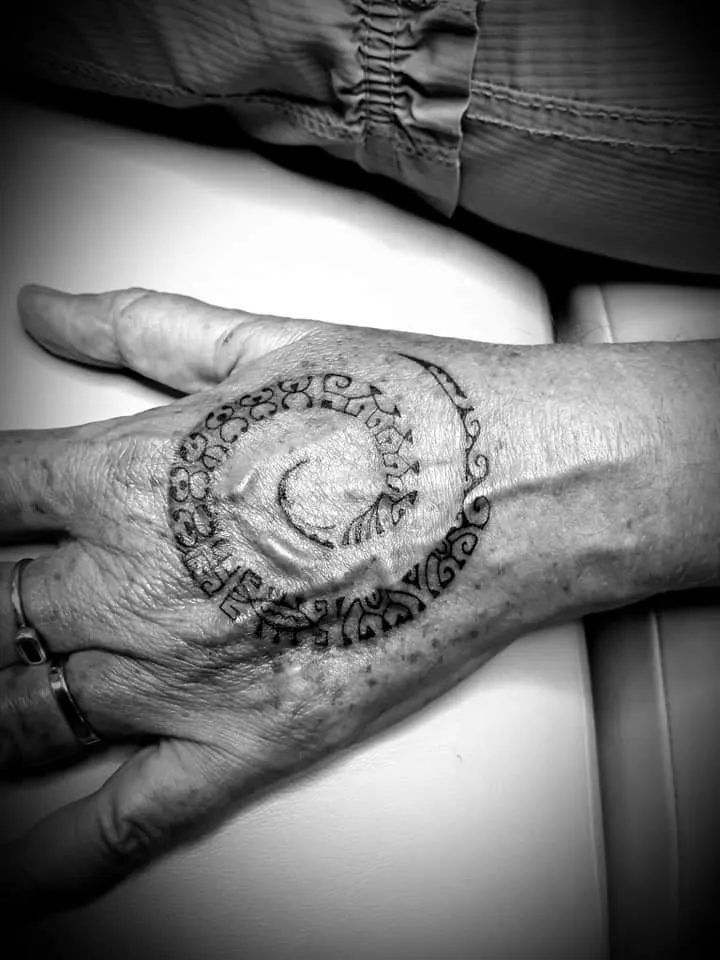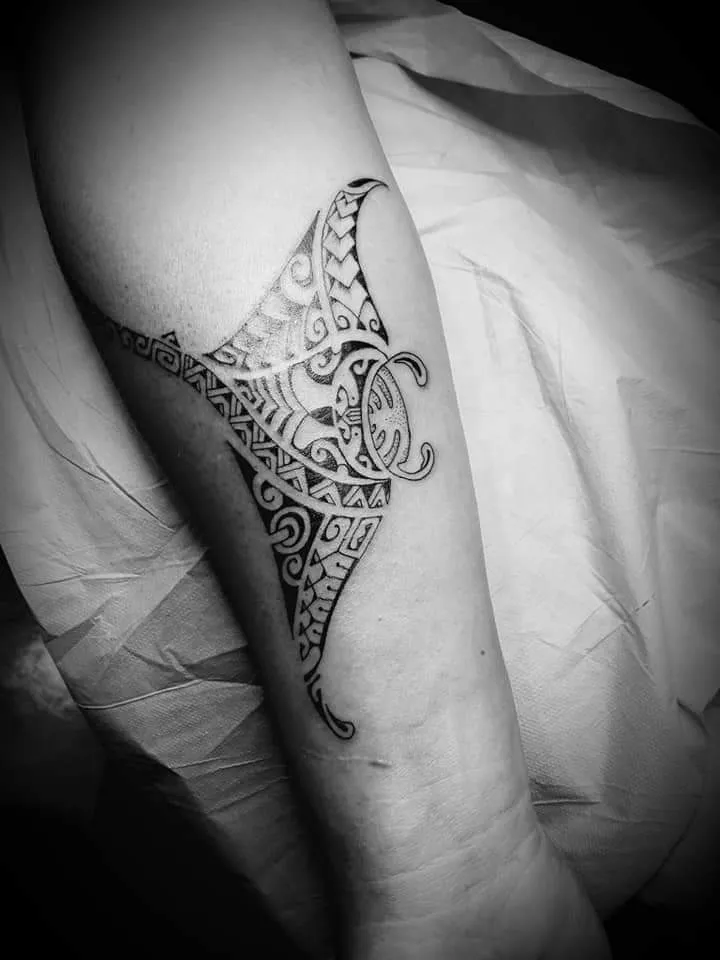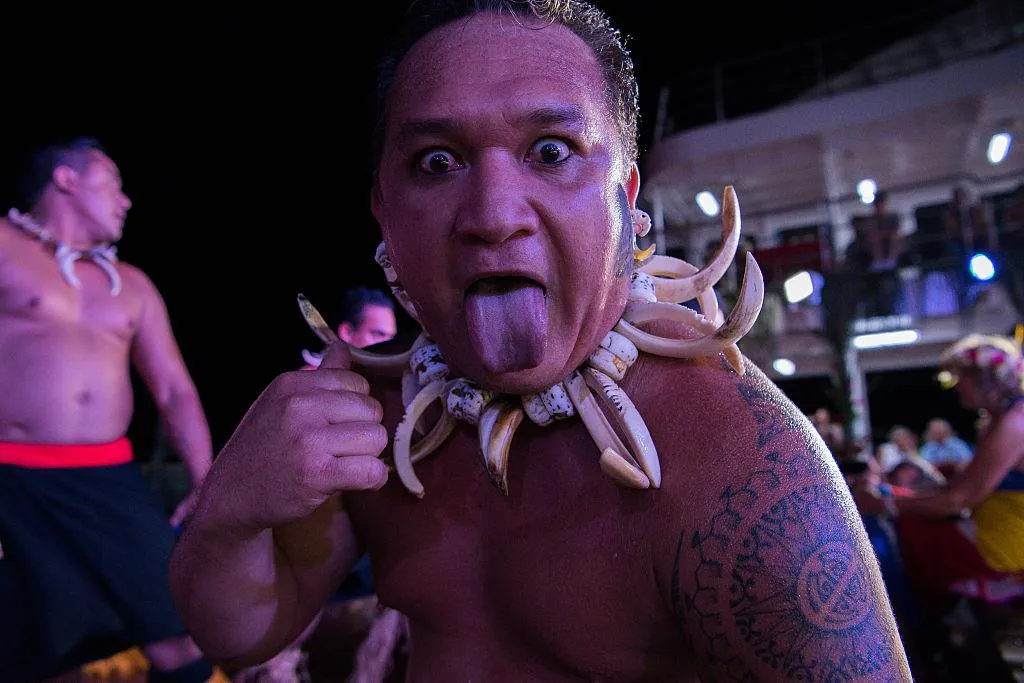This Polynesian Cruise Ship Has a Resident Tattoo Artist
Sailing between Tahiti and the Marquesas, Eddy Tata provides passengers with Polynesian-style tattoos based on their life stories
Born on the 40-square-mile island of Ua Pou in the Marquesas, Eddy Tata learned to draw by watching his Uncle Moana Kohumoetini tattoo. “He was the first tattoo artist in our family,” says Tata, who at 17 years old started tattooing his own skin under his uncle’s guidance. Tata's first ink was a Marquesan cross on his left forearm. By age 30, he completed the necessary training course to tattoo others.
Tata’s childhood passion for drawing alongside his uncle has led to a celebrated career as a highly sought-after Polynesian tattoo artist. Currently, Tata is the resident tattoo artist on the Aranui 5, a passenger-freighter vessel making 14-day voyages between Tahiti and the Marquesas Islands. The 410-foot-long ship is the main lifeline for carrying supplies and tourists around the six islands of Marquesas, and aims to immerse passengers in the culture of French Polynesia. Ninety-seven percent of the staff and crew are Polynesian and hail from all five archipelagos in French Polynesia. The ship offers lectures on Marquesas history, culture and archeology as well as cultural enrichment classes on local dances and songs, making shell leis, and the Marquesan and Tahitian languages. As the onboard tattoo artist, Tata provides passengers with custom Polynesian-style tattoos based on their life stories.
Tattooing has been practiced for at least 2,000 years throughout French Polynesia, which comprises 118 islands stretching over 1,200 miles in the South Pacific Ocean. Older evidence exists of the Egyptians, Inuits and Celts using similar body markings dating back to the Neolithic era. But the modern word for worn permanent art on the skin is derived from the French Polynesian word tatau, which means “to mark.”
“Polynesian tattoos are a non-writing tradition and an Indigenous system of communication,” says Tahiarii Pariente, a Polynesian cultural expert from the island of Raiatea, the second largest of the Society Islands, after Tahiti. He’s a researcher, practitioner and lecturer of Polynesian arts and organizes adventure experiences around the islands.
Traditionally, the bold geometric symbols used in Polynesian tattoos told the personal history and societal rank of the Tahitian who wore them. In the past, the motifs varied from island to island. “In Polynesia, each archipelago had its own motifs but with the arrival of the missionaries, all of the symbols in the other archipelagoes were destroyed, except in the Marquesas,” explains Tata. For instance, a shark’s tooth represents strength, the sky symbolizes spirituality, and waves stand for travel and the ocean. Tata wears a symbol known as Ipu. “It represents the universe, power, aura, but also a woman’s sex since everything originates from there,” says Tata.
Repetitive abstract symbols combined with nature motifs, such as turtles, sharks, ferns, flowers, shells, the sun and the moon, are common, and many of the designs incorporate ancestral stories. “The turtle generally represents peace and longevity. But, in a certain family, they might have a story with an ancestor that was saved by a turtle, so a new meaning is created. A common symbol gets transformed into an exceptional symbol,” Pariente says. Tata wears a turtle and explains that the scales of the turtle’s shell are what specifically symbolize longevity.
According to Pariente, it is customary for men to wear Polynesian tattoos from their upper knees to lower back whereas women usually tattoo their hands. The placement of the tattoos also depends on a person’s family and occupation. His wife, for instance, is a masseuse and has her hand tattooed, but a teacher may get her lower lip tattooed. “The tattoo is also an ID card,” says Pariente. “It's a very unique, personal, highly-customized element of your life and people recognize you because of your tattoo.” He wears several tattoos on his right arms from Tata that represent navigation.“You can see from afar and recognize it is me.”
The Aranui 5, which launched in 2015, converted one of the massage rooms in its spa into a tattoo studio in 2017. At the time, Kohumoetini, who now helps manage the ship’s restaurant, was the onboard tattoo artist. Tata started working in the restaurant on Aranui 5 in July 2016. He began tattooing the crew and, by 2017, joined his uncle as a resident tattoo artist for passengers. According to Romina Wong, director of Aranui Cruise operations, the company is the only cruise ship in the world to have a traditional Polynesian tattoo artist on board. Virgin Voyages is one of the only other cruise ships with an onboard tattoo parlor.
Tata inks specialty designs of ancient symbols and figures on passengers at his onboard studio, Taheiona Patutiki (taheiona being a combination of his children’s names and patutiki meaning tattoo or tattooing in the native Polynesian language of the Marquesas). He sees his service as a way for travelers to commemorate their time in Polynesia—conveniently as they await their passage to their next destination. His motivation is humble; he wants to use his talents and art to connect with people from around the globe. Tata averages 15 tattoos a week—about 700 a year between his private clientele on land and passengers onboard the Aranui 5.
During the cruise, Tata meets with passengers to design their tattoos based on their life stories. “I first discuss with the client to find out what he’d like to represent,” says Tata. “All the pieces I make are unique to the person wearing them. The tattoos tell their story, their experiences, and their feelings. But the symbols used are all the same. It is the symbols and placement together that tells the story.”
Tata is passionate about transcribing passengers’ personal histories onto their skin through the tattoos of his ancestors. "They tell their own story, like in a book that they'll keep for life inked on their skin," Tata says.
A tattoo that stands out to Tata as being one of the most memorable he’s done is a Marquesan sleeve on Australian traveler Brant Tapley. “We really stayed in the spirit of the traditional Marquesan symbols. There was a good feeling between us,” Tata says. Tapley spent two weeks on the Aranui 5 in late November of 2019 exploring the Marquesas Islands. Tapley had been longing to get a tattoo but was never sure what he wanted to permanently etch onto his body until he met Tata. “We spoke at great length about what I wanted the tattoo to represent,” Tapley says. Tata provided Tapley a sketch of his interpretation of the themes they discussed. “His ability to perfectly interpret what I felt and wanted it to represent was incredible,” says Tapley, who feels that the tattoo has given him internal strength. He is a bit secretive when it comes to its symbolism. “It’s a personal story. Only Eddy, myself and my girlfriend know what it truly means,” Tapley says.
The freehand tattoo took about six hours to complete. Tapley’s honored to wear ink created by a Marquesan in the Marquesas, where the history of tattooing extends back millenia. “Every time I see it, it reminds me of that time and the people I met,” Tapley says. He and Tata stay in touch, and he intends to return to Aranui 5 one day to expand the tattoo.
/https://tf-cmsv2-smithsonianmag-media.s3.amazonaws.com/filer/63/cd/63cd7947-c605-4402-9e86-9a36478caded/aranui_5-main.jpg)






